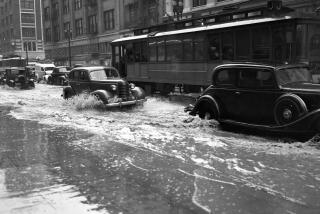California Dreaming
It’s kind of like the game kids play. “made you look!” is the cry of victory--both in child’s play and in the arts.
For decades, David Muench has turned our heads--and held our attention. Dubbed the Ansel Adams of color photography, he has brought us the West’s giant vistas, a West we seldom see but are happy exists somewhere in the general vicinity.
Muench relishes being part of a short--though solid--tradition of Western landscape photographers. What William Henry Jackson did for Yellowstone and Adams for Yosemite, he likes to think he has done for other Western sites, such as Arches National Monument in Utah and the central coast of California. “The more important I make it, the more people will think it’s important,” says Muench.
In a career that spans more than 30 years and 40 books, he has revealed a talent for making wild places seem both familiar and breathtakingly unique. In the way he photographs the twisting sandstone and granite, the vast stretches of undulating desert, the knuckled coast above a boisterous sea, we sense that he has found something--a quality of light and space--that, even had we been there, we would not have seen.
No place is more important to him than the mountains above Santa Barbara, in whose shadow he grew up and still lives. From his own backyard comes one of the more beautiful photographs in his most recent book, “California.” It shows one of the dozens of caves in the Santa Barbara/Ventura area where ancient Chumash paintings can be found. In typical Muench style, there are two focal points. In the foreground is the colorful design of the wall painting. In the background, seen through the entrance to the cave, is an undeveloped stretch of the Santa Ynez Mountains.
Muench is a master of this photographic “near/far,” a compositional technique in which a powerful image in the foreground is played against a sharply contrasting background. He may juxtapose a burst of very living flowers in the foreground with the stark and life-threatening world of a glacier-skirted range of mountains in the background. He knows, he says, that a picture is good “when the edges get hot,” when “opposing primal forces” meet, such as in one scene from “California” shot on the coast. In the background, a splashing wave is set against a Rothko-like sky of muted yellows and grays. In the extreme foreground, the cascading water of an earlier wave, spent on the jutting rock above, rushes back to sea. Talk about opposing forces.
Sometimes the contrast is almost too much, a daring exercise that goes right up to the edge of cliche. More often, though, what he gets is otherworldly--for his book on Utah, he framed a full moon through the sandblasted arch of a rock formation colored in the soft pink light of sunset.
Muench’s father, Josef, was a well-known landscape and commercial photographer, and his son Marc, has joined the family tradition, his work featured prominently in “California.” The book includes numerous examples of how Muench, in his own words, “brings together a time and a place with light.” As Mike Hopkins, Muench’s publisher at Graphic Arts Center Publishing, elaborates: “You get the sense that most photographers rush to get to the perfect place at the perfect time. David’s images are calm, though, as if he’d been sitting there patiently waiting for the shot to happen.”
Sometimes he’s even able to upstage old icons in the process of making new ones. Because of the play of light, a gnarled and writhing juniper tree captures center stage in one photograph in “California.” It takes a moment to realize that the shadowed backdrop to this drama is none other than Yosemite’s venerable Half Dome. Through the eyes of David Muench, it is an image of life in a precarious balance with its awesome surroundings. And in the Chumash cave shot, with the unsullied land in the background, he seems to be saying that we are the threat to the balance. In the 200-plus years we’ve been in California, we’ve destroyed most of the Chumash culture. Will we destroy what’s left of the landscape as well?
More to Read
Sign up for our Book Club newsletter
Get the latest news, events and more from the Los Angeles Times Book Club, and help us get L.A. reading and talking.
You may occasionally receive promotional content from the Los Angeles Times.








